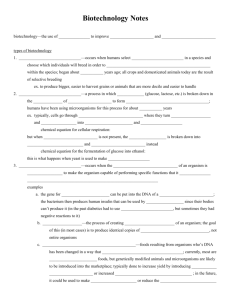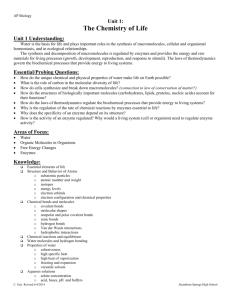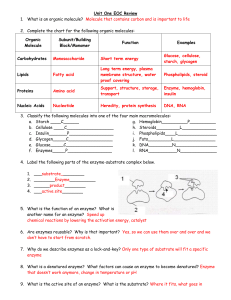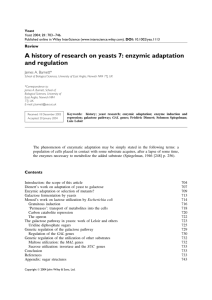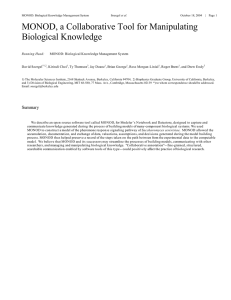Molecular biology (and the use of E
advertisement
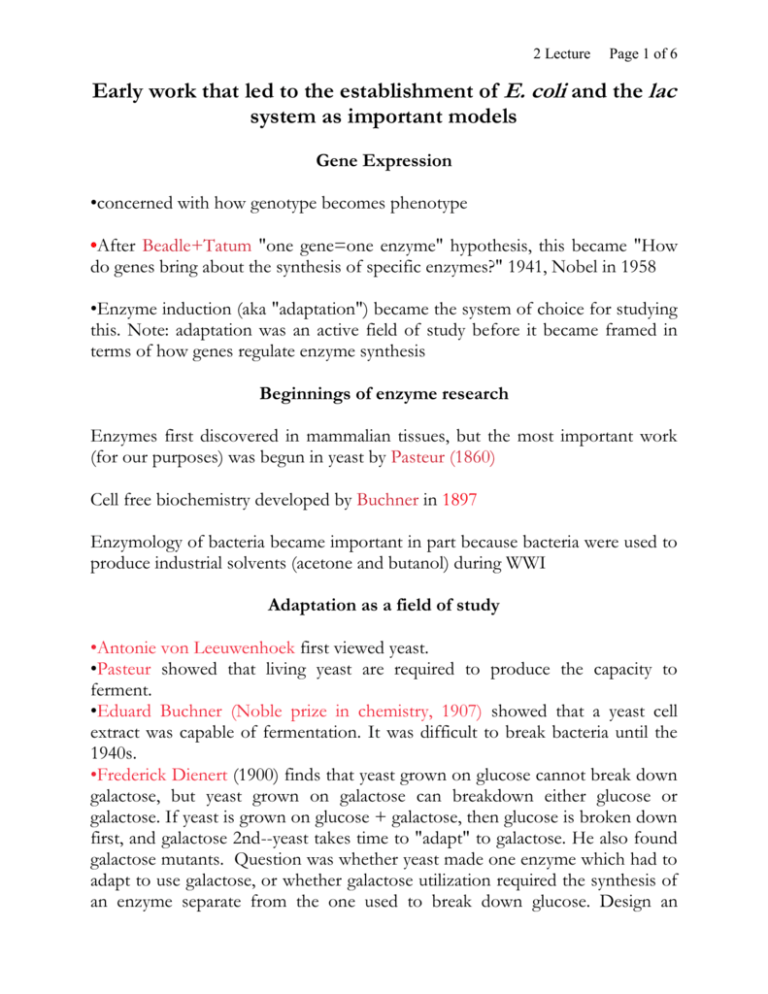
2 Lecture Page 1 of 6 Early work that led to the establishment of E. coli and the lac system as important models Gene Expression •concerned with how genotype becomes phenotype •After Beadle+Tatum "one gene=one enzyme" hypothesis, this became "How do genes bring about the synthesis of specific enzymes?" 1941, Nobel in 1958 •Enzyme induction (aka "adaptation") became the system of choice for studying this. Note: adaptation was an active field of study before it became framed in terms of how genes regulate enzyme synthesis Beginnings of enzyme research Enzymes first discovered in mammalian tissues, but the most important work (for our purposes) was begun in yeast by Pasteur (1860) Cell free biochemistry developed by Buchner in 1897 Enzymology of bacteria became important in part because bacteria were used to produce industrial solvents (acetone and butanol) during WWI Adaptation as a field of study •Antonie von Leeuwenhoek first viewed yeast. •Pasteur showed that living yeast are required to produce the capacity to ferment. •Eduard Buchner (Noble prize in chemistry, 1907) showed that a yeast cell extract was capable of fermentation. It was difficult to break bacteria until the 1940s. •Frederick Dienert (1900) finds that yeast grown on glucose cannot break down galactose, but yeast grown on galactose can breakdown either glucose or galactose. If yeast is grown on glucose + galactose, then glucose is broken down first, and galactose 2nd--yeast takes time to "adapt" to galactose. He also found galactose mutants. Question was whether yeast made one enzyme which had to adapt to use galactose, or whether galactose utilization required the synthesis of an enzyme separate from the one used to break down glucose. Design an 2 Lecture Page 2 of 6 experiment using Yeast minimal medium, galactose, glucose and cyclohexamide (inhibits yeast protein synthesis) to test which is likely to be true. en.wikipedia.org—Antonie_van_Leeuwenhoek en.wikipedia.org—Louis_Pasteur en.wikipedia.org—Eduard_Buchner 1. Read Leeuwenhoek Wiki article 2. Read Buchner article from Milestones (pg65-68) Need to copy. Hennig Karstrom was the first important researcher to study adaptaion in bacteria (1930) •He defined constitutive and adaptive enzymes. Constitutive="enzymes which cells always produce, independently of the composition of the medium in which they have been grown." Adaptive="enzymes which are produced by cells only when required" Defs from Brock's Emergence of Bacterial Genetics •He also differentiated between physiological and genetic adaptation in E. coli. physiological= fast, reversible gain in the ability to use a carbon source like galactose. genetic=gain in function due to mutation. Some E. coli Lac- strains mutate to become Lac+ (the famous E. coli mutabile made by Neisser and Massini 1907) 2 Lecture Page 3 of 6 •Karstrom never came up with a good, mechanistic explanation for adaptation. Basically he said that bacteria adapt when they need to use a new carbon source and don't need to make special enzymes when grown on glucose. This just really restates the observations = "teleological"=explanation of observations by the purpose they serve, rather than by how they are caused Karstrom's work was taken up by the English group led by Marjory Stephenson •They showed that adaption was not due to rare mutations, but was due to changes in all cells in a population. Yudkin and Gale and Stephenson •John Yudkin proposed the mass action theory of enzyme induction. 1938 •Yudkin suggested that enzymes exist within cells in dynamic equilibrium with their precursors, an equilibrium that favors enzyme formation for constitutive enzymes, but favors the inactive precursors in the case of adaptive enzymes. Binding of substrate to adaptive enzymes could stabilize them in the enzyme form. Once bound with substrate, (or product or inhibitor) the rxn would be pulled to the right, because free enyme concentration dropped. precursor<>enzyme>enzyme•substrate •This turned out to be wrong but was very influential for many years. •Monod thought that a precursor enzyme could form many different types of enzymes, and that glucose inhibited the formation of some types of enzymes because it tightly bound the precursor and converted it to the glucose degrading form: 2 Lecture Page 4 of 6 2 Lecture Page 5 of 6 Gene action circa 1945-an example of state of the art What was not known then:•DNA structure, •RNA function, •how proteins were synthesized. What was known: Genes replicate, genes are made of DNA, genes cause enzymes to form, enzymes are specific. •The following model of gene action was presented by Sterling Emerson at the "Gene action in microorganisms" meeting in St. Louis 1945. SLIDES of Emerson’s model from 1945 paper Read Emerson_AnnMissBot_1945 to top of page 246 (G, UG) Jacques Monod •Jacques Monod: Born in 1910 and one of the key players in developing the Lac system as a means to study genetics and gene expression. He won the Nobel Prize in Physiology or Medicine in 1965 along with Andre Lwoff and Francios Jacob. •From Emergence of Bacterial Genetics by T. Brock: "It is important to emphasize that Monod's gropings toward an understanding of the mechanism of gene expression were often erroneous.... it is essential that one not ignore his blunders. In the interests of simplification, and to avoid boring the reader, history is often written as if it moves inexorably in a single direction. Only after an event has transpired can we discard all the erroneous ideas.." SLIDE •His earliest work was on protozoa, and he worked on Drosophila in the laboratory of Thomas Morgan (father of Drosophila genetics) at Cal Tech. •The expert on protozoal growth in the mid-1930s in Europe was Andre Lwoff at the Pasteur Institute in Paris. Andre Lwoff advised Monod not to study protozoa and instead focus on bacteria that could be grown in synthetic media. Monod did his PhD work at the Sorbonne on bacterial growth. Some of his work involved growth of bacteia in cultures containing 2 sugars. In some cases bacteria used the 2 sugars together and in other cases they used one then the other (this was "diauxie") DIAUXIE SLIDES 2 Lecture Page 6 of 6 In 1940 Monod asked about diauxie, Lwoff knew of the work of Deinert and was able to point Monod to the work on "adaptation" in yeast. Monod's work extended that of Henning Karstrom, who also studied "adaptation" in bacteria. •Monod did his PhD work at the Sorbonne on bacterial growth, but interest his work was minimal, so Monod entered the Lwoff lab at the Pasteur in 1945 •Monod concluded that the A sugars inhibited the use of B sugars. He thought of this in terms of adapation--Primary sugars, like glucose prevented cells from adapting to secondary sugars like lactose. More on this later. en.wikipedia.org—Jacques_Monod


